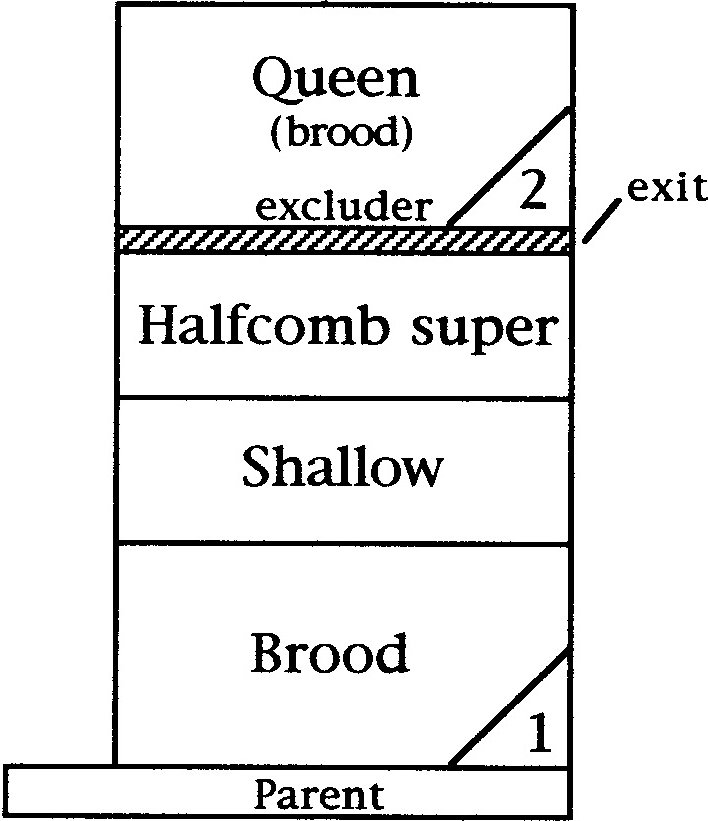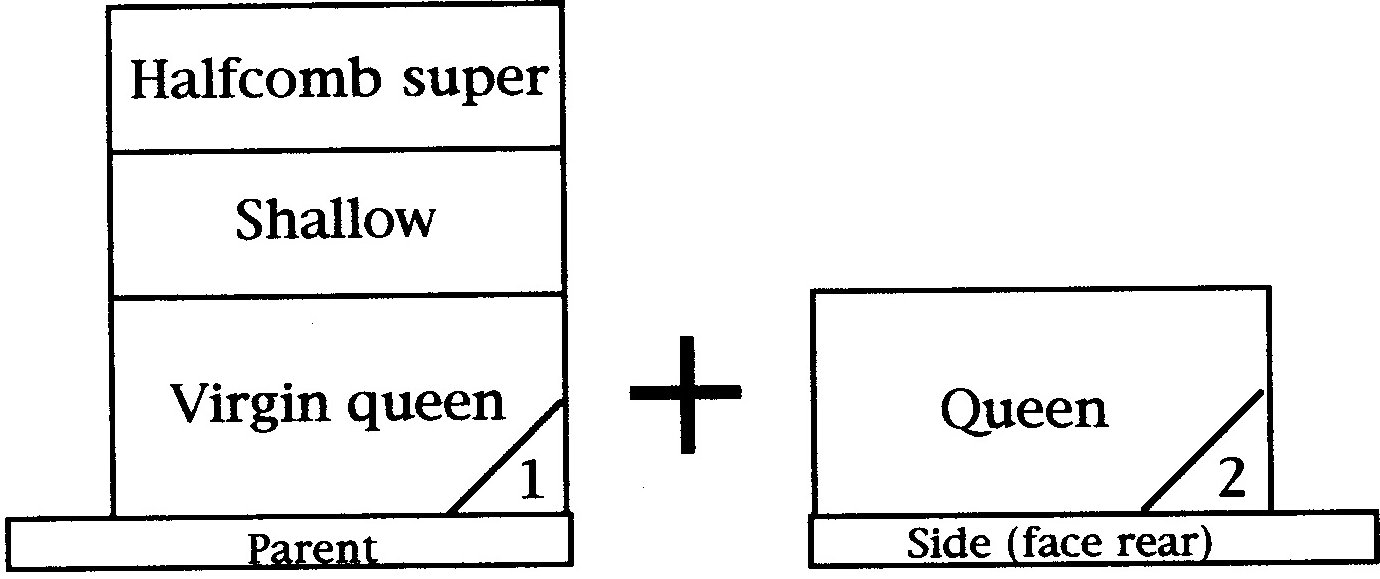Comb Honey Production
“Heart of the Flow” Plan
for producers of extract honey who want to produce some comb honey:
Select strong hives which are already producing extracting honey, obviously not preparing to swarm; and shift temporarily to comb honey production by replacing the extracting supers with two or three comb
honey supers. The extracting supers are stored on weak hive.
The sections will be better filled and capped if one of the extracting supers (partially full) is returned to the top ahead of the others – to sustain foraging momentum. When the comb supers are
full, they are replaced with the other extracting supers.
NOTE: A truly simplistic new scheme with considerable promise may be by the opportunistic use of natural swarms to produce comb honey from supers of extracted honey by housing the swarms in them
under comb supers, as described in ABJ (Nov. 2005).
The method was discovered accidentally by Herman Danenhower, Kutztown, PA while working with the basic Juniper Hill Plan (see below). He says the Juniper Hill Plan adapted to
his region is “The best system of them all. They don’t even come close.”
The “Juniper Hill” Plan
for full season two-stage comb honey production
Spectacular results may be expected when using the basic Juniper Hill Plan. Four or five supers of comb honey (e.g. Halfcomb) may be expected in most regions on strong hives and much more in prime
regions, weather permitting.
Comb honey production by Plan B of the basic Juniper Hill Plan (together with preassembled Halfcomb cassettes) is not tedious, labor intensive or swarm prone – comparable to extracted honey
production.
Also comb honey production by Plan B does not require that beekeepers apply knowledge of honeybee biology and behavior.
Procedure
The bees are induced and/or enabled by procedural design to perform the necessary steps in the right order. Published as Plan B in the American Bee Journal (Feb. 2005) this procedure is the shortest possible comb honey method as well as the least labor intensive.
The following procedure Plan B, Queen-up is started in the spring after the nighttime temperatures have reached the 40’s or more. We now know that the bees will not build the expected queen cells in
the bottom queenless brood chamber below that temperature 30% of the time. In the rare situations where a plan must be started during lower temperatures to be ready for a very early main flow, use Plan A
(Queen-down) which is 100% effective even in cool weather. See Plan A, ABJ, Feb. 05.
The queen of a double brood chamber hive is confined for 16 days in one of the brood chambers (#2) placed at the top over an excluder, notched for front exit. An empty Halfcomb or other comb super, a
shallow food or extracting super, and the other brood chamber (#1) with brood in all stages, follow in that order, as illustrated. Use strong hives that have been deep-swapped to delay early swarming.
|

|
|
The queen is confined in the top chamber at a distance from some of her brood in
the bottom chamber.
|
|
The bees build supersedure queen cells in the bottom queenless brood chamber (#1) from which a virgin
queen is produced, already in place for the first comb honey production on the parent stand. The first virgin to hatch destroys all sister cells for you before the end of the 16-day confinement.
On day 16, before the virgin below is ready to mate, the top queen right brood chamber (#2) is set down to
the side on its own bottom board, facing rear. The excluder is removed. Cage the queen and shake most of
the bees in the side back into the parent. The house bees will stay, but the field bees will find the queen restored to the side. There has been an interruption in the continuity of brood rearing in #1, which
continues until the virgin mates and egg laying is resumed. The interruption of the continuity of brood rearing is the most reliable swarm prevention measure known.
|

|
|
The field bees return and are crowded into the parent stand after the set-down split.
|
|
When the virgin on the parent honey producing stand (#1) mates and begins to lay, honey stockpiled in
vacated brood cells is rushed up into the comb honey super(s) to make room for the queen to lay – an
artificial flow, which is a sign of successful mating. Be prepared to add another super or two promptly. Also, the side hive may need a super before the splits are reunited.
With only a few very young bees and brood, and full time foragers, the side hive is in the best possible condition to accept a new queen if replacement for stock improvement is elected.
After the new queen is known to have brood in all stages (approximately 5 weeks) the two queen right
brood chambers are reunited. With all supers on top, Stage II, comb honey production is continued over a
powerful two-queen colony, or the bees of two queens since only one queen will survive eventually. The
reunion restores the now depleted forager population on the parent stand caused by the interruption in brood rearing at the outset. |